Plough – Share
I could hardly wait to tell you of a blessing received just last week, but leaving for the show I had to put it aside until I could give it full measure of attention.
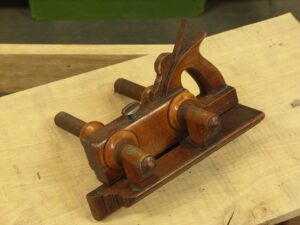
As we talked about the tools my eyes fell unbelievingly onto a very specific plough (plow) plane they had brought because it was one that I had been looking for for a couple of years. Here you see a very lovely plane we call a handled, screw-stem plough plane made from beech and all still fully functioning. The plane was disassembled so I became a little concerned parts might be missing but within seconds I had it together and before you could say “plough plane” I was whisking off shavings like peeling potatoes with a peeler.
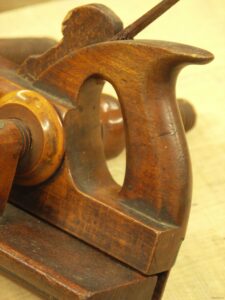
Another aspect you might not understand the reasoning for is the handle of this plough. Not that you wouldn’t understand the handle, but the position of it in relation the body of the plane. Many of the old planes of this type were unhandled because of the extra work it takes to form the handles. But in using and comparing this tool with the unhandled versions something becomes very obvious. With the unhandled version the point of thrust is high up on the plane, right on the rear corner. This is fine most of the time, but when you start working on heavier more dense-grained woods, or even woods such as spruce, the cutter bites and tends to ‘trip’. This is primarily because of what I call centre of thrust or COT. COT means that you have equalled out any pressure to give co-equal force as much as is possible directly behind the cutting edge so that there is no shrinking back that causes uneven pressure mid thrust so as to result in stammer or stagger in the cut.
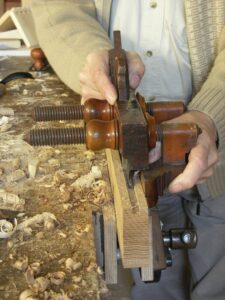
I will soon be making the lid of the chest so I will use it for the grooves to receive the raised panel. Look for it in a couple of days and I will talk you through my experience then.


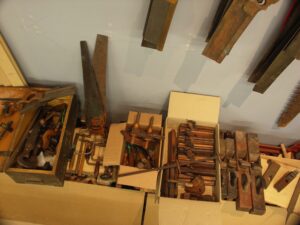
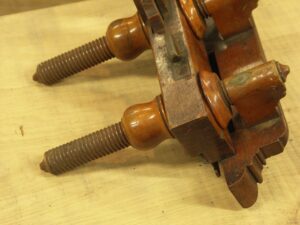
I look forward to hear your “review” of this plough. Especially how it compares to modern LN and vintage Stanley/Record ones.
I have made my choice and struggle to get a somewhat beaten up old wooden plough plane into good working order as a step to replace my router… What has been especially challenging is to make different old plough irons fit into the geometry of this particular plane body.
I used it today and it is phenomenally unfaltering even in the oak I am using. No staggers, no chattering, no answering back at all – pheeenomeeeeenaaaal!!!
Nice to hear, wish I could say the same about mine…
I have managed to make it take ok shavings in pine w. a 5/16″ iron but since this iron is thicker than the original the shavings doesn’t evacuate as they should. Fixable perhaps, but I have already put to much time in to restoring it. Will probably try any way for the rewarding feeling if succeeding.
Hi Paul, this weekend, I was offered a choice “wedge stem plough planes” and similar planes with wider blades, which I rightly or wrongly took to be wooden filletster planes. All had wedges fences. Any thoughts on or experiences of the wedged version, vs, the threaded version? Seemed to me that they might be less convenient & less reliable/fixed, however, you already corrected my similar thoughts on wedged marking gauges, which I used to avoid but now keep an eye out for!